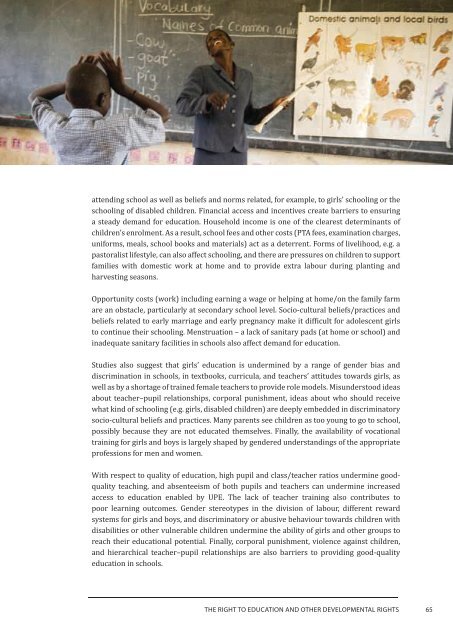<strong>Situation</strong> <strong>analySiS</strong> of Children in uganda 2015The 2008 Education Act stipulates that financing of ECD is not the mandate of government.As such, the MoESTS is only involved in the monitoring and supervision of ECD centresset up by the private sector. 7 Overall, spending on pre-primary education or ECD centres isvery low. According to the 2014/15 education sector ministerial statement, UGX 800 million(less than 0.1% of the total education budget) was allocated for monitoring and supervisionof pre-primary schools during 2013/14 (MoESTS, 2014b).4.4.2 Contextual, supply and demand factorsSocietal factors such as the legacy of the conflict in the North, the HIV/AIDS pandemicand other public health crises have had an impact on the realisation of children’s rightto education. Moreover, gaps between policy and practice, as well as a focus on access –which is only slowly shifting towards implementation, funding, quality and retention – arebarriers to creating an enabling environment for learning and education. Additionally, thepublic sector budget is not sufficient to enable free schooling with reasonable class sizesand adequate facilities, and there is very limited public funding for pre-primary education.Efforts by local authorities to promote UPE vary between regions/localities.On the supply side, there are several factors that act as bottlenecks, including the availabilityof free schooling, physical access to schools, and the availability of good-quality educationthat meets the needs of the community and creates a safe learning environment. Poorlyequipped and inadequate institutions are reflective of a lack of availability of commoditiesthat fulfil the need for education. Access to adequately staffed services, facilities andinformation is a barrier to the supply because the number and accessibility of schoolsvaries between regions and is particularly low in the North. Leakages of resources are alsomajor barriers to ensuring supply: leakages between central government and schools (e.g.ghost teachers, misuse of the grants disbursed by the MoESTS to districts to implement theUPE programme); leakages of resources within schools (e.g. high rates of absenteeism bypupils, teachers and head teachers); deployment of teachers across districts in a way thatis unrelated to measures of need; and inefficient allocation of resources within governmentschools (e.g. large class sizes in early grades and lower sizes at higher grades) (ODI, 2008,cited in Ezati, 2011).In 2010, the Government conducted a country-wide mapping of existing educationalprovision for children requiring special educational arrangements (MoESTS, 2010) and in2011 the MoESTS adopted its first ever Policy of Special Needs and Inclusive Education(MoESTS, 2011a). The aim of the policy is to streamline approaches across the countryvis-a-vis specialised instructional materials, equipment and services, accessibility concerns,learning approaches and provisions, affirmative action, specialised support services,research, partnerships and monitoring and evaluation.The demand for schooling is furthermore affected by the broad societal context (e.g. conflictin the North, economic shocks), socio-economic factors and the (perceived) incentives of7. Private sector investments in ECD through schooling take the form of private for-profit initiatives by individuals, as well as not-for-profitfoundations. A mapping of the balance of these contributions has not been conducted in uganda.64 thE rIGht to EDUCatIoN aND othEr DEvELoPMENtaL rIGhtS
<strong>Situation</strong> <strong>analySiS</strong> of Children in uganda 2015attending school as well as beliefs and norms related, for example, to girls’ schooling or theschooling of disabled children. Financial access and incentives create barriers to ensuringa steady demand for education. Household income is one of the clearest determinants ofchildren’s enrolment. As a result, school fees and other costs (PTA fees, examination charges,uniforms, meals, school books and materials) act as a deterrent. Forms of livelihood, e.g. apastoralist lifestyle, can also affect schooling, and there are pressures on children to supportfamilies with domestic work at home and to provide extra labour during planting andharvesting seasons.Opportunity costs (work) including earning a wage or helping at home/on the family farmare an obstacle, particularly at secondary school level. Socio-cultural beliefs/practices andbeliefs related to early marriage and early pregnancy make it difficult for adolescent girlsto continue their schooling. Menstruation – a lack of sanitary pads (at home or school) andinadequate sanitary facilities in schools also affect demand for education.Studies also suggest that girls’ education is undermined by a range of gender bias anddiscrimination in schools, in textbooks, curricula, and teachers’ attitudes towards girls, aswell as by a shortage of trained female teachers to provide role models. Misunderstood ideasabout teacher–pupil relationships, corporal punishment, ideas about who should receivewhat kind of schooling (e.g. girls, disabled children) are deeply embedded in discriminatorysocio-cultural beliefs and practices. Many parents see children as too young to go to school,possibly because they are not educated themselves. Finally, the availability of vocationaltraining for girls and boys is largely shaped by gendered understandings of the appropriateprofessions for men and women.With respect to quality of education, high pupil and class/teacher ratios undermine goodqualityteaching, and absenteeism of both pupils and teachers can undermine increasedaccess to education enabled by UPE. The lack of teacher training also contributes topoor learning outcomes. Gender stereotypes in the division of labour, different rewardsystems for girls and boys, and discriminatory or abusive behaviour towards children withdisabilities or other vulnerable children undermine the ability of girls and other groups toreach their educational potential. Finally, corporal punishment, violence against children,and hierarchical teacher–pupil relationships are also barriers to providing good-qualityeducation in schools.thE rIGht to EDUCatIoN aND othEr DEvELoPMENtaL rIGhtS65




